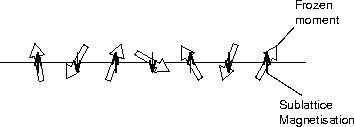One apparent randomness of the Zn-doped samples appeared as the
distribution of the Néel temperatures (Fig.57).
The spread of ![]() , which probably originates from inhomogeneity of
the sample, may have smeared out the
, which probably originates from inhomogeneity of
the sample, may have smeared out the ![]() SR spectral structures, as discussed
in the following.
SR spectral structures, as discussed
in the following.
We may suppose that the spread of ![]() was caused by an inhomogeneity of the
Zn concentration (x). Using the
was caused by an inhomogeneity of the
Zn concentration (x). Using the ![]() phase diagram shown in
Fig.53, the distribution of the Néel temperatures
(
phase diagram shown in
Fig.53, the distribution of the Néel temperatures
(![]() ) may be mapped to a fluctuation of the Zn
concentrations. The result yields
) may be mapped to a fluctuation of the Zn
concentrations. The result yields ![]() and 0.5 % for the x=2, 4 and 8 % systems, respectively. These
variations of the Zn concentrations may be mapped to the spread of the
field-width
and 0.5 % for the x=2, 4 and 8 % systems, respectively. These
variations of the Zn concentrations may be mapped to the spread of the
field-width ![]() using the inset of
Fig.57; the result becomes
using the inset of
Fig.57; the result becomes ![]() and 0.04 for the x=2, 4 and 8 %
samples, respectively. The above-mentioned spreads are all
Gaussian standard deviation.
and 0.04 for the x=2, 4 and 8 %
samples, respectively. The above-mentioned spreads are all
Gaussian standard deviation.
The ![]() SR spectrum with the spread of internal fields can be obtained from a convolution:
SR spectrum with the spread of internal fields can be obtained from a convolution:
 to be
the relaxation observed in the Si 2% single crystal (eq.59).
In the small inhomogeneity limit (
to be
the relaxation observed in the Si 2% single crystal (eq.59).
In the small inhomogeneity limit (
In Fig.61, we show a simulated ![]() SR spectrum
for the Zn 4% doped system (
SR spectrum
for the Zn 4% doped system (![]() ),
obtained from a numerical integration of eq.60. The precession became less
obvious than the Si-doped crystal; this result implies that the
macroscopic sample inhomogeneity may be one of the reasons for the absence
of muon spin precession in the Zn-doped systems.
),
obtained from a numerical integration of eq.60. The precession became less
obvious than the Si-doped crystal; this result implies that the
macroscopic sample inhomogeneity may be one of the reasons for the absence
of muon spin precession in the Zn-doped systems.
The effects of more microscopic randomness, such as substitutions to the
spin site with the non-magnetic Zn ions, are not clear at the present stage.
 |